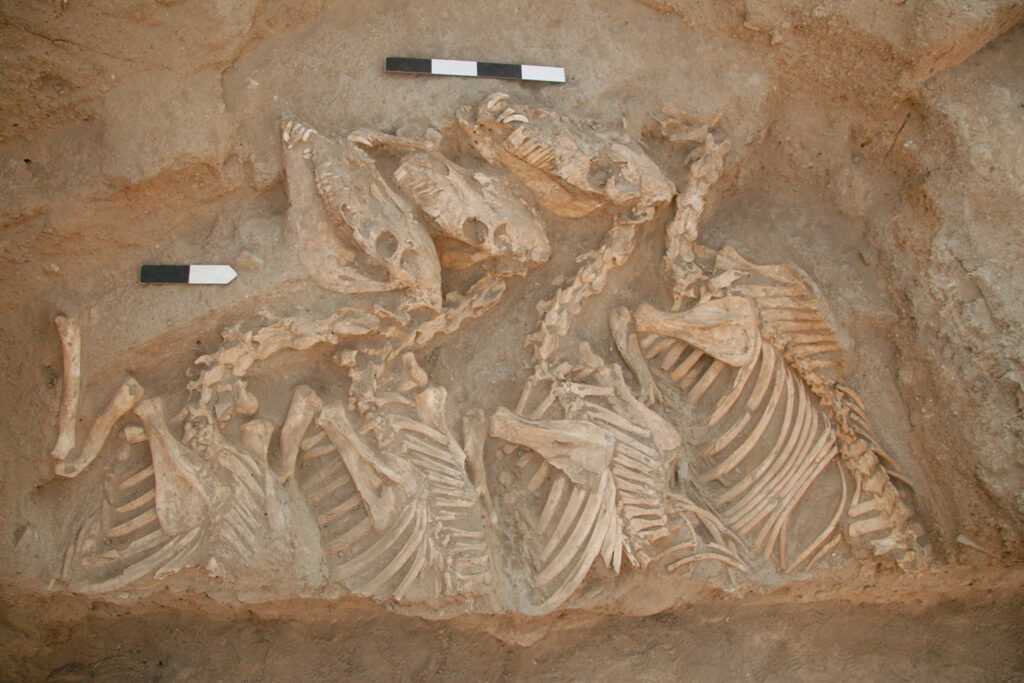“Kungas” – the Oldest Equine Hybrids
Bavarian State Collection of Palaeoanatomy
The Sumerians evidently used horse-like animals in their war campaigns as early as 4,500 years ago. For the first time, a team of French researchers has been able to use ancient DNA analyses to taxonomically classify the earliest hybrid animals bred by humans, which were used in warfare in Mesopotamia in the 3rd millennium B.C. – and thus long before the appearance of domestic horses in that region. Prof. Joris Peters, Director of the Bavarian State Collection of Paleoanatomy and Chair of Paleoanatomy, Domestication Research and History of Veterinary Medicine at the LMU Munich, was also involved in the study. The scientists have now published their results in the scientific journal SCIENCE ADVANCES.
Horses played an essential role in the history of organized and higher warfare. In addition to horses, the equid family also includes various species of wild donkeys and zebras. While domesticated horses were not used in warfare south of the Caucasus until about 4,000 years ago (Guimaraes et al., 2020), the Sumerians were already using donkeys several hundred years earlier to pull chariots carrying war equipment. One such situation is evidenced by the famous “Standard of Ur,” a c. 4,650-year-old Sumerian mosaic from the southern Mesopotamian city of Ur in present-day Iraq. However, the taxonomic classification of the draught animals used and their relationships have remained a mystery to researchers to this day. On cuneiform tablets of that time, the animals were described as valuable and socially highly regarded so-called “kungas”. A team of researchers led by Dr. Eva-Maria Geigl of the Institut Jacques Monod, Université de Paris, the University Museum of Archaeology and Anthropology, Philadelphia, and Johns Hopkins University, with the participation of the Bavarian State Collection for Paleoanatomy, has now solved the mystery.
A study of ancient genes has shown: The Bronze Age “kungas” appear to be the earliest human-bred hybrids between two donkey species, because they were first-generation offspring of crosses between female domestic donkeys (Equus asinus asinus) and male Syrian wild donkeys (Equus hemionus hemippus). The latter became extinct at the beginning of the 20th century.
The so-called ancient DNA analyses – the examination of DNA from ancient tissues, which were carried out in Paris – provided information. For their study, the scientists examined the DNA of equine bones from the approximately 4,500-year-old elite burial site of Umm el-Marra in what is now northern Syria. They compared their analyses with DNA signatures in a c. 11,000-year-old bone of a Syrian wild ass from the Early Neolithic cult site of Göbekli Tepe (Turkey), the analysis and identification of which was performed by longtime Göbekli Tepe researcher and animal bone expert Prof. Joris Peters, director of the Bavarian State Collection for Paleoanatomy (SNSB-SPM) and chair of paleoanatomy, domestication research and history of veterinary medicine at LMU Munich. The last living specimens of the Syrian wild donkeys lived in the Schönbrunn Zoo in Vienna at the end of the 19th and beginning of the 20th century. Their bones are preserved in the Natural History Museum of Vienna. The ancient genomes of the bones found at Umm el-Marra, as well as their burial in elite tombs, suggest that these hybrid equids correspond to the “kungas”, which were mentioned several times on Bronze Age cuneiform tablets and were considered comparatively expensive, as one paid six times as much for such an animal as for a domestic donkey. With the introduction of the horse in the 2nd millennium B.C. the probably not quite uncomplicated breeding of donkey hybrids became insignificant, since now a domestic animal was available, which, in comparison to the domestic donkey, was hardly inferior to the kungas regarding speed.
Publication:
Bennett, E.A., Weber, J., Bendhafer, W., Champlot, S., Peters, J., Schwartz, G., Grange, T., Geigl, E.-M. (2022) The genetic identity of the earliest human-made hybrid animals, the kungas of Syro-Mesopotamia. Science Advances. Vol.8, Issue 2. DOI: 10.1126/sciadv.abm0218
Contact:
Prof. Dr. Joris Peters
Staatssammlung für Paläoanatomie (SNSB-SPM)
Kaulbachstr. 37 III, 80539 München
Tel: +49 (0)89 / 2180 – 5711
E-Mail: peters@snsb.de


